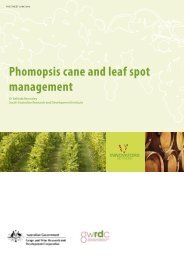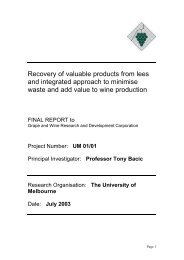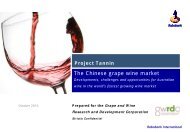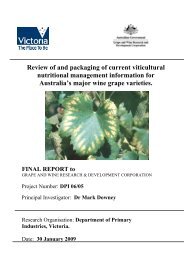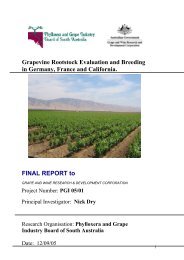Identification of the major drivers of 'phenolic' taste in ... - GWRDC
Identification of the major drivers of 'phenolic' taste in ... - GWRDC
Identification of the major drivers of 'phenolic' taste in ... - GWRDC
Create successful ePaper yourself
Turn your PDF publications into a flip-book with our unique Google optimized e-Paper software.
AWRI: <strong>Identification</strong> Of The Major Drivers Of ‘Phenolic’ Taste In White W<strong>in</strong>es<br />
produce irritation exist. Oleocanthal is one such compound. It is responsible for <strong>the</strong> peppery, back <strong>of</strong><br />
<strong>the</strong> throat burn<strong>in</strong>g sensation that typifies extra virg<strong>in</strong> olive oil. Recently, oleocanthal receptors located<br />
<strong>in</strong> <strong>the</strong> human pharynx have been identifed (Peyrot des Gachons et al. 2011).<br />
The ‘burn<strong>in</strong>g after<strong>taste</strong>’ perceived by <strong>the</strong> assessors was negatively associated with both <strong>in</strong>-mouth<br />
hotness (r= -0.331) and hot after<strong>taste</strong> (r= -0.395), suggest<strong>in</strong>g that ‘burn<strong>in</strong>g after<strong>taste</strong>’ represents a<br />
sensory character that is not totally related to alcohol content. However, <strong>the</strong> model w<strong>in</strong>e (that<br />
conta<strong>in</strong>ed alcohol but not phenolics) was rated as hav<strong>in</strong>g a burn<strong>in</strong>g after<strong>taste</strong>, suggest<strong>in</strong>g that alcohol<br />
<strong>in</strong>duced hot after<strong>taste</strong> and a similarly perceived phenolic <strong>in</strong>duced character were not totally<br />
differentiated by <strong>the</strong> <strong>taste</strong>rs.<br />
Add<strong>in</strong>g caftaric acid to <strong>the</strong> model w<strong>in</strong>e suppressed <strong>the</strong> perception <strong>of</strong> burn<strong>in</strong>g after<strong>taste</strong>, while add<strong>in</strong>g<br />
GRP tended to <strong>in</strong>crease burn<strong>in</strong>g sensation. This suggests that GRP produces a burn<strong>in</strong>g sensation <strong>in</strong> its<br />
own right, while <strong>the</strong> presence <strong>of</strong> caftaric acid <strong>in</strong>terferes with <strong>the</strong> burn<strong>in</strong>g after<strong>taste</strong> <strong>in</strong>duced by alcohol.<br />
Therefore two mechanisms are likely to be <strong>in</strong> play.<br />
GRP was found to have an enhanc<strong>in</strong>g effect on ‘oily mouth-feel’ (Figure 7-7, p=0.096). The<br />
relationship between perceived viscosity and oil<strong>in</strong>ess is less clear as <strong>the</strong>y were moderately correlated<br />
(r= 0.53, p=0.141). However, by keep<strong>in</strong>g both ‘oily mouth-feel’ and ‘viscosity’ <strong>in</strong> <strong>the</strong>ir list <strong>of</strong> relevant<br />
attributes, <strong>the</strong>y were seen as dist<strong>in</strong>ct characters worthy <strong>of</strong> <strong>in</strong>clusion by <strong>the</strong> tast<strong>in</strong>g panel.<br />
What is new here is <strong>the</strong> notion that small molecular weight phenolics from white w<strong>in</strong>es may suppress<br />
astr<strong>in</strong>gent and ‘burn<strong>in</strong>g after<strong>taste</strong>’ sensations aris<strong>in</strong>g from acidity or alcohol ra<strong>the</strong>r than caus<strong>in</strong>g <strong>the</strong>m<br />
as has previously been presumed. The mechanisms underly<strong>in</strong>g this are unclear but warrant fur<strong>the</strong>r<br />
<strong>in</strong>vestigation. While <strong>the</strong>re is evidence that GRP contributes to a burn<strong>in</strong>g after<strong>taste</strong>, <strong>in</strong> general, GRP<br />
and caftaric acid when <strong>taste</strong>d at w<strong>in</strong>e like concentrations have ei<strong>the</strong>r no effect or a suppressive effect<br />
on ‘phenolic <strong>taste</strong>s’ <strong>in</strong> white w<strong>in</strong>e.<br />
61<br />
Astr<strong>in</strong>gency<br />
3.0<br />
2.5<br />
2.0<br />
1.5<br />
1.0<br />
0.5<br />
0.0<br />
b<br />
a<br />
b<br />
Caftaric Acid GRP<br />
b<br />
a a<br />
60 mg/L<br />
30 mg/L<br />
0 mg/L<br />
Figure 7-3: Mean ‘astr<strong>in</strong>gency’ <strong>in</strong>tensity. Means with different subscripts are significantly<br />
different (p




